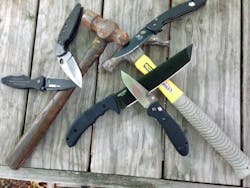I remember walking into the “Café” on a stabbing call. When my partner and I walked through the front door we saw Johnny, a local pimp, ex-con and dredge of society, sitting on a chair holding his intestines in his hand. We arrested the suspect at his apartment next door, another “denizen of the criminal stratum of society.” Johnny survived – ain’t it just the way?
Over my 30+ year police career I’ve seen countless victims of edged weapon attacks. In addition, I’ve seen too many victims of baseball bat, club or bludgeon attack as well (even chairs). Indeed, having worked a couple of years as a deputy assigned to corrections I knew that even in a secure environment, such as a county jail, that inmates could quickly fabricate (and use) an improvised shiv in short order from a toothbrush, pen or whatever piece of plastic or wood they could get their hands on.
Yet, we hear from former chief of police and expert witness Melvin Tucker the following:
“It’s time trainers stop teaching officers the “21 foot rule” and start telling officers the truth about the real risks they face from a suspect with a knife. Why, because the fear of serious bodily harm or death from stabbing is an “unreasonable fear.” Defense Against Edged Weapons and “Unreasonable Fear” (2014; ILEETA Journal)
This nonsense has been repeated by the Police Executive Research Forum (PERF) in their 30 Guiding Principles published earlier this year. Quoting PERF, “Point #16: Use Distance, Cover, and Time to replace the outdated concepts such as the “21-foot rule” and “drawing a line in the sand.”
The Realities
The facts on police use of force are clear. When we examine the Washington Post statistics on police use of deadly force in 2015, we find that:
- 167 Suspects armed with edged weapons shot and killed
- 100 Were attacking or aggressing officers or others
Sports fans that means that 60% of the subjects shot and killed by police were attacking officers or others with those weapons.
Item: Glendale, Ohio – A patrolman pulls up to investigate a subject hitchhiking on I-75 in that city. The officer asks the suspect to place his hands on the back of the patrol car for a pat-down (never a good idea as it offers no control) when the suspect draws a knife and slashes at the officer. The officer gets some distance, draws and fires wounding the suspect in the abdomen. The suspect continues to move, albeit slowly, toward the officer telling the officer to, “shoot me.” Turns out that this subject had murdered someone in Baltimore and was on the run.
Lots of lessons here:
- Unknown stops mean unknown weapon status
- An offender can quickly draw and slash or cut you
- There is no such thing as a “one shot stop”
- Most suspects who’ve been shot eventually stop based on exsanguination (blood loss) and that takes time
Tactics
Here’s some sound tactics on dealing with subjects armed with edged weapons:
“If you spot the danger signs early enough, you can probably avoid the confrontation altogether. A tactical withdrawal…may be your best bet… …You should move to cover (if there is any close at hand), draw your weapon, and start to plan your next move. Why use cover…you want to make it hard for him to get to you.”
These wise thoughts were penned by Dennis Tueller, you know, the police firearms trainer whose revolutionary concepts published in SWAT Magazine in 1983 How Close is Too Close. Yet, without conducting any worthwhile study of the dangers of edged weapons Tucker, PERF and others want us to believe that we should not be worried about the dangers of edged weapons. They point to tactics employed by constables in the United Kingdom. These valiant law enforcers who are, for the most part, unarmed, are forced to deal with suspects armed with knives with batons, OC spray and Tasers. Sadly PERF advocates these tactics as well as the use of riot shields to control subjects armed with knives or other edged weapons which are in many cases deadly force situations. Let’s be clear, UK constables don’t shoot suspects armed with knives who are attacking them, because they don’t carry guns. We need not use these tactics in spontaneous attacks when a suspect armed with a knife is actively attacking.
Item: This month a mentally ill subject armed with a knife, attacked an officer in Cincinnati as the officers pulled up in front of a grocery store after the suspect robbed the store and threatened a security guard with his knife.
Though violently attacked by the suspect, the Black Lives Matter crowd insisted that the officers should have attempted some form of less-than-lethal control.
Let’s return to Dennis Tueller for some tactical answers:
“Sometime, of course, despite your best efforts, you could find you are suddenly, at close quarters, the intended victim of some lunatic slasher. If you are an expert in one of the many martial arts, you may opt to go at it hand-to-hand, and if you are in this category you do not need advice from me on how to do it. So, we'll get back to the use of the handgun for solving the problem. What it all comes down to now is your ability to smoothly and quickly draw your pistol and hit your adversary, and do it all reflexively. And the only way to develop these reflexes is through consistent, repetitive practice, practice, practice.”
Item: Years ago I was working patrol when we received a call of a mentally ill subject, armed with two knives, who was slashing the top of his own head. When we arrived on scene the subject’s mother pointed him out as he attempted to walk away from the residence. The subject had the knives in his hands held in his outside coat pockets. This was before Taser came on the scene but we did have contact ERD’s – Electronic Restraint Devices, in the form of Ultron II “stun guns.” Yours truly, believing the suspect was a threat to other citizens if he escaped, ran up behind him and tackled him (forcefully) to the ground. Once on the deck I laid into him with the stun gun (the only way the thing would work because if you broke contact the circuit was broken – similar to a “drive stun” with a Taser) and we were able to get his arms behind his back and cuffed.
Wrap-Up
When I look back at this incident, I realize the danger of such a move. All the suspect had to do was get an arm/knife free and stab or slash an artery and I could have bled out on the sidewalk. Though our options in those days were limited this type of use of force (tackle) is extremely dangerous. Might get you a medal of valor (mine didn’t…) but how many awards are based on doing really stupid stuff?
Know the dangers of edged weapons, ball bats, hammers, clubs and other bludgeons. Understand that if time and circumstances permit get distance, back-up and other force options such as the Taser or beanbag rounds. But if a suspect is actively attacking you, then understand you’re in a deadly situation – and a stab, slash or smash to the head can cause your death.
About the Author
Kevin Davis
Tactical Survival Contributor
Kevin R. Davis retired from the Akron Police Department after 31 years with a total of 39 years in law enforcement. Kevin was a street patrol officer, narcotics detective, full-time use of force, suspect control, and firearms instructor, and detective assigned to the Body Worn Camera Unit. Kevin is the author of Use of Force Investigations: A Manual for Law Enforcement, and is an active consultant and expert witness on use of force incidents. Kevin's website is https://kd-forcetraining.com/

